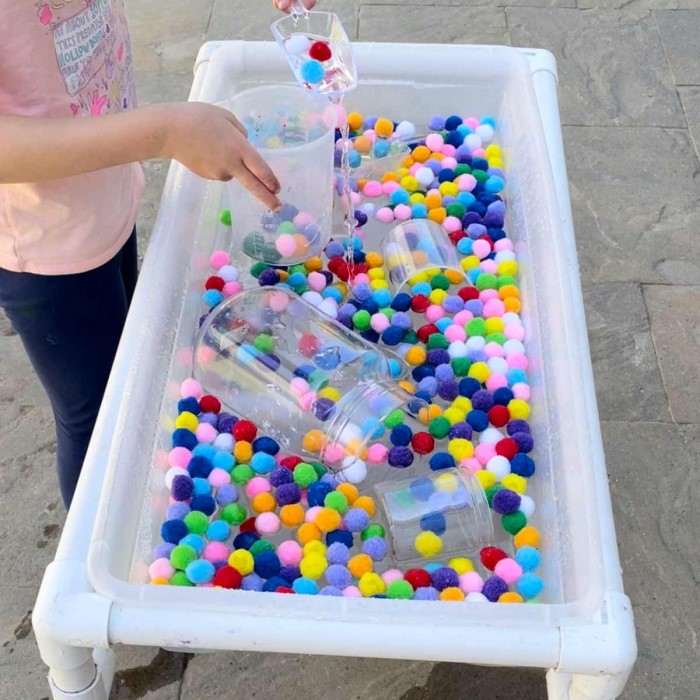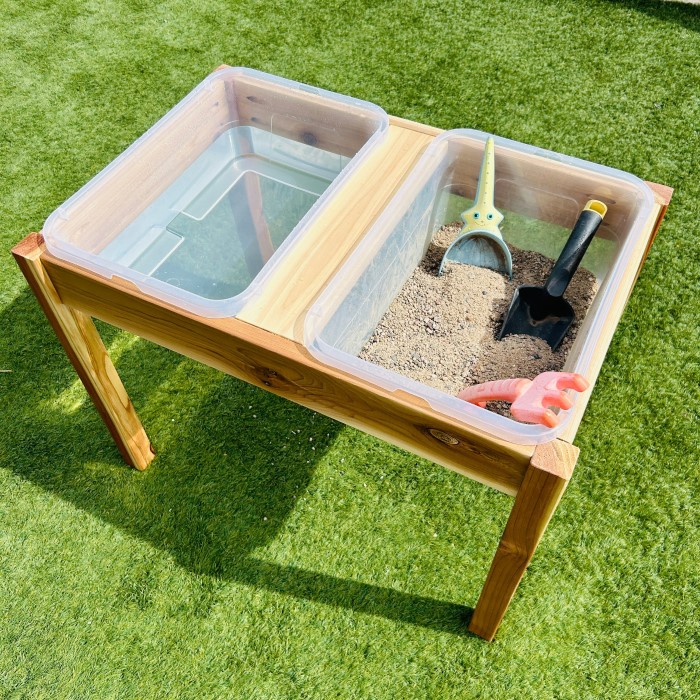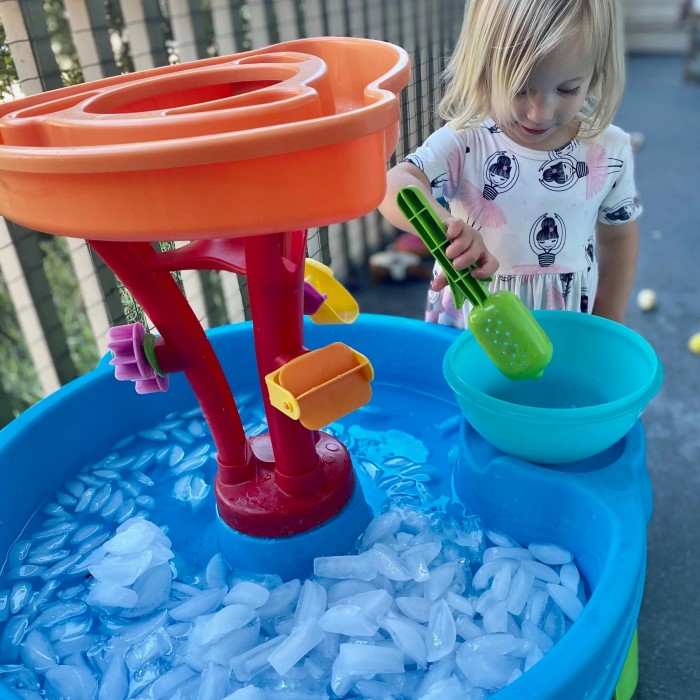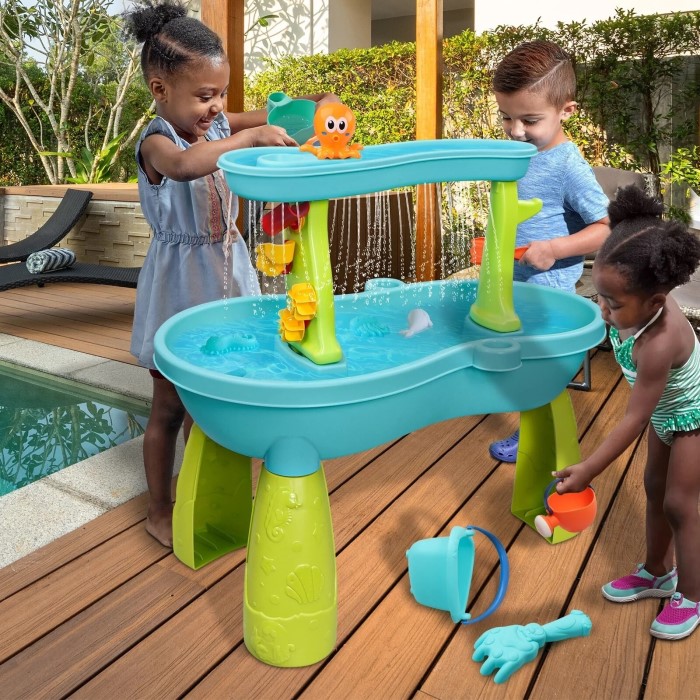Introduction
Water sensory table is engaging tools for children’s play and learning. They encourage exploration and creativity. Filled with water and other materials, they provide endless fun and discovery. These tables support sensory experiences, making them perfect for hands-on activities.
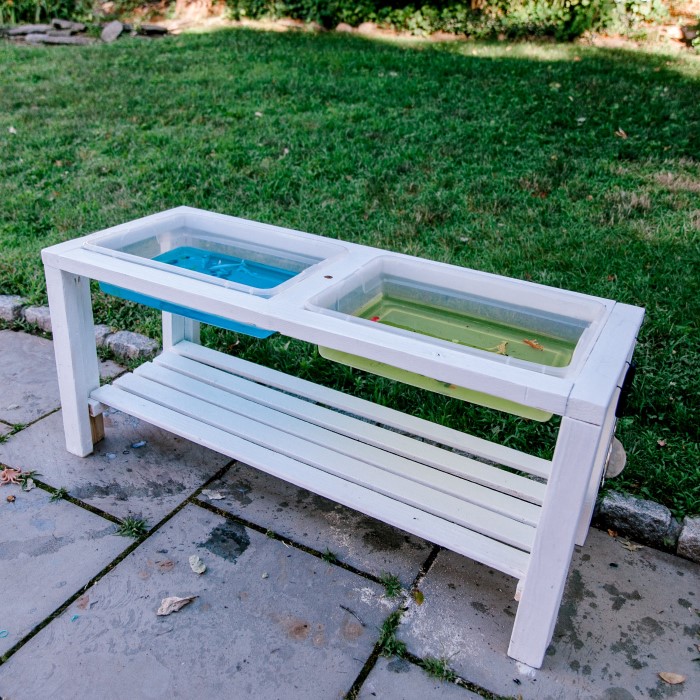
What is a Water Sensory Table?
A water sensory table is a play surface designed for water-based activities. It usually includes a basin for holding water and may feature adjustable legs. Some designs include compartments for sand, toys, or other materials. These tables allow children to explore water in a controlled and fun environment. They are popular in homes, schools, and daycare centers.
Benefits of Using Water Sensory Tables for Children
Using a water sensory table benefits children in various ways:
- Improves Fine Motor Skills: Activities like pouring water or picking up small items enhance hand coordination.
- Stimulates the Senses: Touching, splashing, and experimenting with water engages sensory systems.
- Encourages Problem-Solving: Kids can experiment with floating, sinking, or mixing materials.
- Fosters Creativity: Children create stories and scenarios while playing with water.
- Promotes Relaxation: Water play often has a calming effect on young children.
- Enhances Social Skills: Group activities around the table encourage sharing and teamwork.
Incorporating a water sensory table into playtime offers more than just fun. It supports child development in entertaining and meaningful ways.
Setting Up a Water Sensory Table
Setting up a water sensory table is simple and exciting. With a little preparation, children can dive into fun and learning. Here’s how to get started.
Necessary Materials and Supplies
To set up a water sensory table, gather these items:
- Water Sensory Table: Choose one with compartments if possible.
- Water: Ensure clean water is available for play.
- Toys and Tools: Include items like cups, funnels, strainers, and small toys for variety.
- Color Additives: Use non-toxic dyes or natural colorants for experiments.
- Ocean or Sand Themes: Add shells, stones, or sand for creative play.
- Smocks or Aprons: Protect clothes from water spills.
- Towels and Mats: Keep the floor dry and safe.
By having the right supplies, children can explore endlessly and stay engaged.
Tips for Choosing a Suitable Location
Select a fun and safe spot to set up the table:
- Indoors: Use a waterproof mat or set up near easy-to-clean surfaces.
- Outdoors: Choose a shaded location to keep kids comfortable.
- Accessibility: Ensure the table height is comfortable for children.
- Keep It Safe: Avoid areas with electrical outlets or unsafe objects nearby.
A good location encourages hassle-free play while keeping the environment safe.
Keeping Safety in Mind
Safety always comes first during play. Follow these tips:
- Supervision: Always watch children while they play with the water sensory table.
- Water Levels: Use shallow water to minimize risks.
- Non-Toxic Materials: Only use safe, non-toxic elements for play.
- Clean Regularly: Prevent mold or bacteria by emptying and cleaning after each use.
- Non-Slip Mats: Reduce chances of slipping with anti-slip mats.
Mindful preparation ensures kids have a fun and safe experience. With these steps, you can create an enjoyable learning environment for little ones.
Creative Activities for Water Sensory Play
Water sensory tables offer endless opportunities for creativity and learning. Use these engaging activities to encourage exploration and fun with a water sensory table.
Floating and Sinking Experiments
Teach kids about buoyancy with floating and sinking experiments:
- Gather small items like corks, coins, and plastic spoons.
- Have children predict which items will float or sink.
- Place each item in the water to test predictions.
- Discuss why some items float and others sink.
This activity fosters curiosity and introduces basic scientific concepts.
Exploring Colors and Dyes in Water
Make water play vibrant and colorful:
- Add a few drops of non-toxic food coloring or natural dyes.
- Mix primary colors to create secondary colors.
- Use clear containers to observe color blending.
- Incorporate objects like sponges to soak and release colored water.
Color exploration develops creativity and understanding of color science.
Using Cups, Funnels, and Strainers for Fun
Incorporate tools to enhance fine motor skills:
- Provide items like cups, funnels, spoons, and strainers.
- Let kids practice pouring, scooping, and transferring water.
- Create challenges such as filling containers to specific levels.
- Explore how different tools affect water flow.
These activities strengthen hand coordination and problem-solving skills.
Adding Small Toys and Figurines
Encourage imaginative play with toys:
- Add waterproof figurines, rubber animals, or boats.
- Create pretend scenarios, such as underwater adventures or rescue missions.
- Use props like pebbles or fake plants for added realism.
- Rotate toys to keep the activity fresh and engaging.
Toys promote storytelling and shared play, enhancing social skills and creativity.
With these activities, a water sensory table becomes a hub of exploration and development.
Seasonal Themes
Water sensory tables can be adapted to match each season, bringing excitement all year round. Incorporating seasonal themes keeps the play experience fresh and inspires creativity.
Summer Fun: Beach and Ocean Themes
Summer is the perfect time for beach-themed water play. Here’s how to create an ocean vibe:
- Include Sand and Shells: Add sand, shells, and small rocks to the table for a beach feel.
- Use Marine Toys: Incorporate toy boats, starfish, or plastic sea animals to spark imaginations.
- Add Blue Color: Use food coloring to make water look like the sea.
- Ice Refreshers: Freeze water in shapes like fish or boats for a cooling effect.
- Encourage Role Play: Children can pretend to be sailors, mermaids, or beach explorers.
This theme engages kids in fun summer adventures at home.
Winter Activities: Ice and Snow Explorations
Transform water sensory tables into a winter wonderland with these ideas:
- Ice Play: Freeze toys or objects in chunks of ice for kids to melt and discover.
- Snow-Like Materials: Add fake snow or shaving cream for a snowy effect in the play area.
- Cold Water Fun: Use cold water and let kids explore frost or icy feelings.
- Winter Props: Include items like snowmen figurines, polar animals, or tiny scarves for creativity.
- Experimenting: Let kids observe how ice melts and changes form.
This theme is great for sensory exploration during chilly weather.
Fall and Spring Inspired Play Ideas
Celebrate the changing seasons with engaging fall and spring-themed activities:
Fall Ideas:
- Add pumpkin-shaped toys or autumn colors like orange and red to the table.
- Explore with leaves, acorns, or mini gourds for tactile play.
- Encourage floating experiments with dried leaves.
Spring Ideas:
- Include plastic flowers, butterflies, or toy insects to capture the essence of spring.
- Use warm-colored water to depict blooming nature.
- Create mini rivers or rain simulations using funnels.
These seasonal ideas nurture creativity while teaching kids about nature.
Seasonal themes transform water sensory tables into exciting and educational playgrounds for every time of year.
Educational Benefits of Water Sensory Play
Water sensory tables provide a unique blend of fun and learning. They promote child development in several ways. By engaging in hands-on activities, children improve skills that benefit them throughout life.
Development of Fine Motor Skills
Fine motor skills are crucial for many everyday tasks. Water sensory table activities enhance these skills effectively:
- Pouring and Scooping: Kids use tools like cups or spoons to practice controlled movements.
- Picking Up Small Objects: Manipulating items like toys and stones sharpens hand coordination.
- Building Strength: Repetitive water play strengthens fingers and wrists.
- Precision Practice: Activities like filling containers teach accuracy and focus.
These efforts help children develop better handwriting, dressing skills, and tool usage over time.
Encouraging Scientific Exploration and Inquiry
Water sensory tables are perfect for introducing basic science concepts. They stimulate curiosity and promote thoughtful experimentation:
- Buoyancy Testing: Kids learn why objects float or sink through simple hands-on experiments.
- Color Mixing: Using dyes, they discover how primary colors create secondary ones.
- Physical Properties: Exploring water textures and temperatures builds observation skills.
- Cause and Effect: Actions like pouring water from a funnel show immediate results, teaching logical thinking.
These activities encourage children to ask questions and find answers through experimentation.
Promoting Social and Cooperative Play Among Children
Water sensory tables also foster teamwork and interaction. Group play around the table builds essential social skills:
- Sharing Tools: Children learn to share cups, toys, and other items.
- Communication Practice: Activities often require verbal collaboration, building language skills.
- Problem-Solving Together: Working as a team to solve challenges helps kids cooperate effectively.
- Role-Playing Games: Pretending together around the table enhances creativity and social bonding.
These interactions prepare children for stronger relationships and teamwork in school and beyond.
Cleaning and Maintenance Tips
Keeping your water sensory table clean and well-maintained ensures safer and longer use. Regular upkeep also prevents hygiene issues, making playtime enjoyable for children.
How to Properly Clean a Water Sensory Table
- Empty the Table Completely: Pour out all water and remove any remaining toys or tools.
- Rinse Thoroughly: Use clean, warm water to rinse the surface and compartments.
- Use Mild Soap: Wash the table with a gentle, non-toxic soap to remove dirt or stains.
- Scrub Gently: Use a soft sponge or cloth to scrub corners and hard-to-reach areas.
- Dry Completely: Wipe down the table with a dry towel to avoid dampness or residues.
- Disinfect Periodically: Use a child-safe disinfectant occasionally to eliminate bacteria or germs.
Regular cleaning ensures a safe and hygienic play environment for kids.
Preventing Mold and Mildew
Mold and mildew can form if the table is not dried properly. Follow these tips to prevent it:
- Dry After Each Use: Ensure all surfaces are completely dry before storage.
- Clean Toys and Tools: Wash and dry any items that were in the water to prevent mold buildup.
- Use Air Circulation: Store the table in a well-ventilated area to keep moisture away.
- Avoid Stagnant Water: Never leave water sitting in the table after use.
- Inspect Regularly: Check for early signs of mold and address them immediately with a cleaning solution.
Preventive care keeps the table fresh and safe for repeated use.
Storage Solutions for Long-Term Use
Proper storage protects your water sensory table from damage and extends its lifespan:
- Disassemble When Possible: If the table has removable parts, take them apart for compact storage.
- Use Protective Covers: Cover the table with a waterproof sheet to keep dust and dirt out.
- Store Indoors: Keep the table in a dry, sheltered location to avoid weather-related wear.
- Organize Accessories: Place toys, tools, and other items in labeled containers for easy retrieval.
- Inspect Before Storing: Ensure everything is clean and dry to avoid unpleasant surprises later.
With proper storage, your water sensory table remains in excellent condition for years of fun.
FAQs
Water sensory tables provide a world of possibilities for play and learning. Below are answers to common questions about these fantastic tools.
Age Recommendations for Use
Water sensory tables are suitable for various ages. Here’s a breakdown:
- Toddlers (18+ months): Offer shallow water with simple toys. Supervise closely for safety.
- Preschoolers (3-5 years): Add learning tools like funnels and strainers. Experiment with floating and sinking.
- School-Age Children: Incorporate creative themes and science-focused activities to keep older kids engaged.
- Age-Specific Considerations: Adjust water levels, tools, and themes as per age appropriateness.
Always supervise children during play to ensure safe and enjoyable experiences.
How to Engage Reluctant Learners
Some children may hesitate to explore a water sensory table. Try these strategies:
- Start Small: Offer a single toy or activity to build interest gradually.
- Use Themes: Choose themes like oceans or seasons that match the child’s interests.
- Mix Colors: Add vibrant water colors to draw excitement.
- Make It Social: Encourage group play to reduce shyness.
- Show Examples: Demonstrate fun activities like pouring water or floating objects.
Adapt approaches to meet individual preferences and curiosity levels.
Suitable Alternatives for Small Spaces
If space is limited, consider these alternatives:
- Mini Sensory Containers: Use small bins or trays for similar water play experiences.
- Sink Play: Let children explore water activities safely at a sink or basin.
- Portable Table Models: Invest in compact, foldable water sensory table.
- Outdoor Setup: Utilize balconies or yards with small, manageable setups.
- Creativity with Bowls: Use large bowls to mimic a sensory table experience.
These options ensure children enjoy sensory play no matter the space available.
With the right approach, every child can benefit from the fun and learning of water sensory play.
Conclusion: Enjoying Your Water Sensory Table Experience
In conclusion, a water sensory table offers endless opportunities for fun and learning. With its numerous benefits, engaging activities, and easy setup, it becomes a valuable resource for any home. Dive into stimulating play that promotes sensory exploration, social interaction, and creative storytelling.
As you explore these hands-on activities, remember to embrace the laughter and joy that water play brings. By fostering a playful environment, you encourage a love for learning that lasts a lifetime. Enjoy the experience and let your child’s imagination flow freely!
